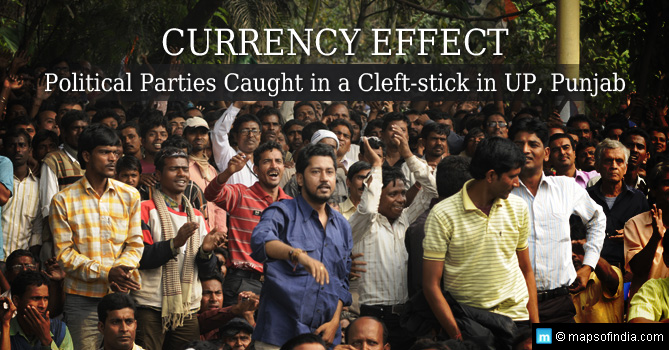In poll bound states like Uttar Pradesh and Punjab, the Central government’s announcement for demonetization of Rs 500 and Rs 1000 notes seems to have caught political parties and their leaders off guard. A few months away from assembly polls, the announcement has come with imponderable negative meanings to them. While it may adversely affect electioneering campaign, involving huge money power, it may deeply hurt them where it matters: Donations.
Drug smugglers, liquor barons, hawala money dealers and also some of the real estate owners whose business generally thrive on slush and unaccounted money, donate huge sum to parties in return for political protection they get from them. The move to demonetize high valued currency has in one stroke sniffed off activities of these elements, including underworld mafias, who are running a sort of parallel economy in the country.
As per an estimate, of the country’s total population as much as 25 to 30 percent of people operate without a bank account. Such unaccounted money, whose source is not available with the Election Commission, is the key source of sustenance for political parties in the country. This is supported by the Association of Democratic Reforms (ADR), an organization which is relentlessly working for greater transparency and accountability in the country’s political system.
What is finding of ADR?
On the basis of its analysis of I-T returns of political parties, the ADR in its 2015 report said that political parties declared collecting Rs 2,338.53 crore during the 2004, 2009 and 2014 parliamentary elections. Of this money, the ADR said, Rs 1,039 crore was collected in cash and Rs 1,299.53 crore by cheques.
Sources of more than 90 percent of funds collected in cash were never disclosed. Amid this, surfaced the disappointing revelations; during the 2014 Lok Sabha polls as much as Rs 330 crore in cash was seized from political parties by the EC, which had no account at all and they were meant for the campaign funding.
In this background, when Rs 500 and Rs 1,000 notes have been declared illegal tender, it is in the realm of speculation how political parties may suffer with this move. If experts are to be believed, political parties and their leaders have been thrown into a frustrating situation as they will not be able corner as much money in cash as they require for their high-voltage campaigning in Uttar Pradesh and Punjab.
During 71 assembly elections held across the country between 2004 and 2015, political parties declared collecting Rs 2,108 crore in cash and only Rs 1,245 crore in cheque. The cash component, forming a larger share of the total collection, indicated that it was preferred by political parties because they found it easy to hide its source.
Can it help curb black money?
Experts like former Chief Election Commissioner S Y Quraishi are of the belief that this move will have an impact on the flow of money in elections in Uttar Pradesh and Punjab — the two states where money plays a big role. But he also added that political parties may find different mechanisms and routes to convert their unaccounted money into accounted money. Other experts feel that the announcement will hit hard those regional parties which are dependent on their supporters and candidates for collection of funds for elections.
Yet, there are some who have come up with an exceptional formula. Candidates who have forked-out money to the tune of Rs 50 lakh to Rs 4 crore to regional parties to get tickets are now being told to withdraw their money and replace it with gold and diamonds. But make no mistake, regional players have yet to master the sophisticated ways to dodge the revenue intelligence wing of the Income Tax department. Experts say that political parties will not be able to hoodwink the existing regulatory system 1oo percent. Their stand is that the political parties may dodge the system in maximum 10 to 20 percent cases, how much hard they may try, but not more.
Who will be hit hard?
It is said that small-time businessmen like poster and banner makers, flag and flower sellers will suffer maximum hit with the demonetization move. Lack of cash flow will force political parties to curtail their expenditure on poster- and banner-making. Not only that, the fireworks industry, catering service providers and others will also bear the brunt of the central government’s move.
According to a rough estimate, from stage making to decorations to audio sets (speakers and mics) to chairs to banners to coolers and air-conditioners – each political meeting involves an expenditure of Rs 15-20 lakh. Then, the LED displays, which are put up during campaigns cost around Rs 70,000 to Rs one lakh. These will perhaps see scaled down in arrangement now. Political parties may also put a curb on the use of vehicles during campaigns.
Instead, they will save money to go for selective digital platforms to enhance their visibility. How will they use the media — both print and electronic — is a question lying uppermost in everyone’s mind. It should be recalled that with each election, it had become fashionable among big political players to organize high-voltage campaigns; which involved hiring of event management firms, some of them from foreign countries like America, Germany and Hong Kong.
Perhaps, these things will have to change now, and change, as the current drive of demonetization taught us, is inevitable.
Read More
Can India really become cashless?
How to Convert Black Money into White
Spiritual Life Lessons after Note Ban in India
Why is Rs 500 Note Banned in India?
Features of New Rs 500 and Rs 2000 Currency Notes
Rs 500 and Rs 1000 Note Ban Imapct on Economy, Real Estate and Other Sectors
Why India Banned 500 Rupee Currency Notes
Rs 500 and Rs 1000 Notes Banned, New Rs 2,000 Note to be out on 10th November
Will India be able to bring back the Black Money?
Modi’s Vision for Banking Industry
Black Money Law: Will it Make a Positive Difference?





